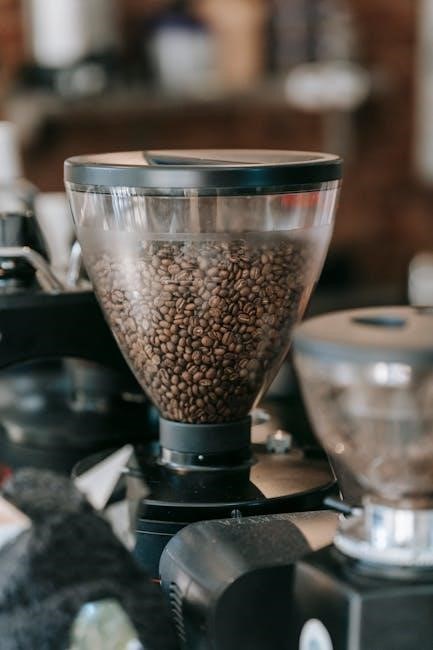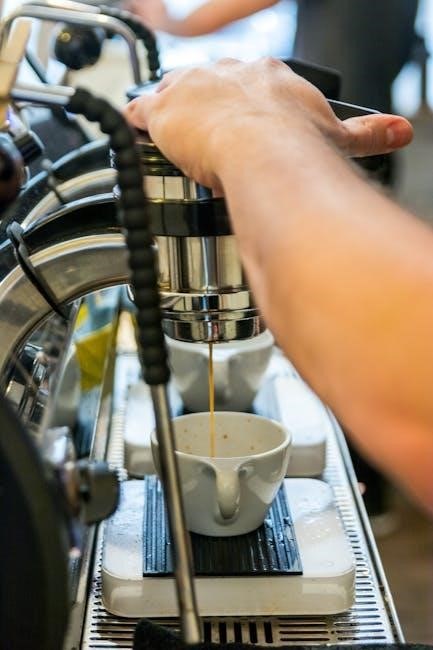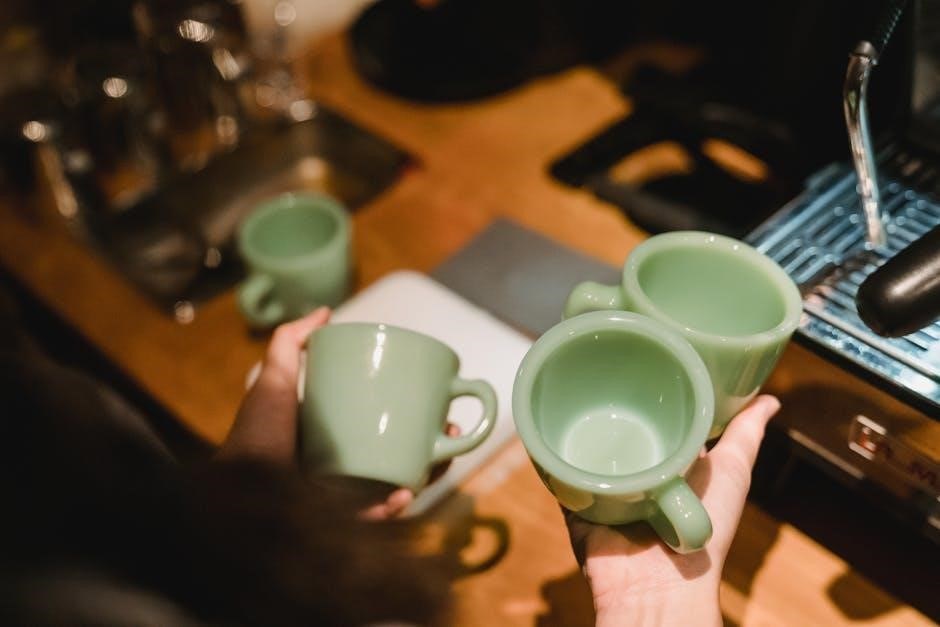coffee grind size chart pdf

Coffee Grind Size Chart: An Overview
Choosing the correct coffee grind size is crucial for optimal flavor extraction. This chart serves as a tool to help you differentiate grind sizes. It simplifies coffee brewing‚ offering a comprehensible approach with grind ranges for popular methods.
Importance of Grind Size
The grind size directly impacts the flavor extracted from coffee beans. Achieving the right grind is key to a balanced brew. Too coarse‚ and the water won’t extract enough flavor‚ leading to a weak‚ sour cup. Too fine‚ and over-extraction occurs‚ resulting in a bitter‚ harsh taste. Understanding the relationship between grind size and brewing method is essential. Different brewing methods require specific grind sizes to ensure proper extraction. For instance‚ a French press needs a coarse grind to prevent sediment from passing through the filter‚ while espresso requires a fine grind to create the necessary pressure for extraction. Experimenting with grind sizes allows you to fine-tune your brewing process and discover your preferred flavor profile. Using a coffee grind size chart helps you match the grind to the brewing method. Grinding coffee right is crucial for achieving the best flavor. The consistency of the coffee grinds is also important. A uniform grind ensures even extraction‚ preventing some particles from being over-extracted while others are under-extracted. Burr grinders are recommended for their ability to produce a more consistent grind compared to blade grinders. Remember‚ the ultimate goal is to extract the right amount of flavor from the beans. A visual coffee grind size chart can guide you in choosing the best size for your brewing method. Consider how your favorite brewing method works and adjust your grind accordingly.

Grind Size Chart: Visual Guide
This visual guide helps you select the ideal grind size for your brewing method. It offers a clear comparison of different grind textures‚ from extra coarse to extra fine‚ enabling you to achieve optimal extraction and flavor in every cup.
Extra Coarse Grind
The extra coarse grind is the largest of the grind sizes‚ resembling peppercorns or rock salt in texture. With a particle size around 1.5 mm‚ it’s noticeably chunky. This grind is particularly well-suited for brewing methods that involve prolonged contact between the coffee grounds and water‚ allowing for a slower‚ more controlled extraction. Due to its large particle size‚ the surface area exposed to water is relatively small‚ preventing over-extraction and bitterness that can occur with finer grinds in longer brewing times.
Recommended Brewing Methods:
- Cold Brew: Extra coarse grind is ideal for cold brew coffee‚ where the grounds steep in cold water for an extended period‚ typically 12-24 hours. This slow extraction process benefits from the larger particle size‚ resulting in a smooth‚ low-acid concentrate.
- Cowboy Coffee: This traditional method involves boiling coffee grounds directly in water. The extra coarse grind prevents the coffee from becoming overly bitter during the prolonged boiling process.
Characteristics:
- Texture: Resembles peppercorns or rock salt.
- Particle Size: Approximately 1.5 mm.
- Extraction Rate: Slow due to the reduced surface area.
- Flavor Profile: Produces a mellow‚ less acidic flavor‚ especially in cold brew.
Why it Works:
The extra coarse grind prevents over-extraction during long brewing times. The larger particles ensure that the water doesn’t quickly pull out all the flavors from the coffee‚ resulting in a balanced and less bitter cup. This makes it perfect for methods where the coffee grounds are in contact with water for many hours.

Tips:
- When using an extra coarse grind‚ ensure you use the correct coffee-to-water ratio to achieve the desired strength.
- Adjust the brewing time based on your preference; longer steeping times will result in a stronger brew.
Coarse Grind
A coarse grind is slightly finer than extra coarse‚ resembling coarse sea salt or kosher salt. Its particle size is smaller than peppercorns‚ but still noticeably chunky. This grind size is ideal for brewing methods that require a relatively short immersion time‚ preventing over-extraction and bitterness. The larger particles ensure a slower extraction rate compared to finer grinds‚ allowing for a balanced flavor profile.
Recommended Brewing Methods:
- French Press: Coarse grind is the standard for French press brewing. The larger particles prevent the grounds from passing through the filter‚ resulting in a cleaner cup with a full body.
- Percolator: While not as common today‚ a coarse grind is suitable for percolators‚ where the coffee is repeatedly cycled through the grounds.
- Some Cold Brew Variations: Some cold brew recipes call for a coarse grind‚ particularly when using a shorter steeping time than the traditional 12-24 hours.
Characteristics:
- Texture: Similar to coarse sea salt or kosher salt.
- Particle Size: Smaller than peppercorns‚ but still visibly chunky.
- Extraction Rate: Slower than finer grinds‚ preventing over-extraction in shorter brew times.
- Flavor Profile: Produces a full-bodied cup with a balanced flavor‚ avoiding excessive bitterness.
Why it Works:
The coarse grind prevents the French press filter from clogging and ensures that the coffee doesn’t become overly bitter during the immersion process. The larger particles provide a slower extraction‚ resulting in a smoother‚ more balanced cup compared to using a finer grind.
Tips:
- When using a coarse grind in a French press‚ avoid stirring the coffee too vigorously‚ as this can lead to a muddier cup.
- Adjust the brewing time based on your preference; typically‚ 4 minutes is recommended for a French press.
- Ensure your grinder produces a consistent coarse grind to avoid inconsistent extraction.
Common Mistakes:
- Using a grind that is too fine for a French press‚ which can result in a gritty texture and bitter taste.
- Over-stirring the coffee‚ which can disrupt the extraction process and lead to a less clean cup.
Medium Grind
A medium grind is a versatile size‚ often described as having a texture similar to coarse sand or sugar. It’s finer than coarse grind but not as powdery as fine grind. This grind size is a good all-around choice for several popular brewing methods‚ providing a balance between extraction speed and preventing over-extraction.
Recommended Brewing Methods:
- Drip Coffee Makers: Medium grind is the standard for automatic drip coffee makers. The size allows for proper water flow and extraction without clogging the filter.
- Pour Over (Cone-Shaped Filters): While some prefer a medium-fine grind‚ a medium grind can work well with pour over methods like Hario V60 or Chemex‚ depending on the filter and brewing technique.
- Siphon Coffee Makers: Medium grind is typically recommended for siphon coffee makers‚ ensuring consistent extraction and proper filtration.
Characteristics:
- Texture: Similar to coarse sand or sugar.
- Particle Size: Smaller than coarse grind‚ but larger than fine grind.
- Extraction Rate: Moderate‚ allowing for a balanced extraction in various brewing methods.
- Flavor Profile: Produces a well-rounded cup with good body and clarity.
Why it Works:
The medium grind allows for a consistent and even extraction in drip coffee makers and pour over methods. It provides enough surface area for the water to interact with the coffee grounds‚ resulting in a flavorful cup without excessive bitterness or sourness.
Tips:
- Adjust the grind size slightly based on your taste preferences. Finer for a stronger brew‚ coarser for a milder brew.
- Ensure your drip coffee maker is clean and properly maintained for optimal performance.
- Experiment with different coffee beans to find the perfect flavor profile for your medium grind.
Common Mistakes:
- Using a grind that is too coarse for a drip coffee maker‚ which can result in a weak and under-extracted brew.
- Using a grind that is too fine‚ which can clog the filter and lead to a bitter taste.
- Overfilling the filter with coffee grounds‚ which can also lead to clogging and uneven extraction.
Fine Grind
A fine grind is characterized by its powdery texture‚ resembling that of table salt or flour. This grind size is best suited for brewing methods that require a short extraction time and high pressure‚ as the small particles allow for rapid flavor release.
Recommended Brewing Methods:
- Espresso Machines: Fine grind is essential for espresso‚ as the high pressure forces hot water through the tightly packed coffee grounds‚ extracting a concentrated shot of coffee.
- Moka Pots (Stovetop Espresso Makers): Similar to espresso machines‚ moka pots rely on pressure to brew coffee‚ requiring a fine grind for optimal extraction.
- Aeropress: While versatile‚ the Aeropress often benefits from a fine grind‚ especially when using a shorter brewing time.
Characteristics:
- Texture: Powdery‚ similar to table salt or flour.
- Particle Size: Smallest of the commonly used grind sizes (excluding extra fine).
- Extraction Rate: Very fast‚ due to the large surface area exposed to water.
- Flavor Profile: Produces a strong‚ concentrated flavor with a rich body. Can easily become bitter if over-extracted.
Why it Works:
The fine grind allows for maximum contact between the water and coffee grounds‚ resulting in a quick and efficient extraction. This is crucial for espresso and moka pots‚ where the brewing time is short and the pressure is high.
Tips:
- Use a high-quality burr grinder to achieve a consistent fine grind.
- Adjust the grind size based on the specific espresso machine or moka pot being used.
- Tamp the coffee grounds firmly and evenly when making espresso.
- Be mindful of brewing time to avoid over-extraction and bitterness.
Common Mistakes:
- Using a grind that is too coarse for espresso‚ which can result in a weak and sour shot.
- Over-tamping the coffee grounds‚ which can restrict water flow and lead to uneven extraction.
- Using a low-quality grinder that produces inconsistent particle sizes.
- Brewing for too long‚ which can cause over-extraction and bitterness.
Extra Fine Grind
An extra fine grind has a very fine‚ almost flour-like consistency. This grind is specifically designed for brewing methods that require the finest possible particle size to achieve proper extraction. The most common application for an extra fine grind is Turkish coffee‚ also known as Ibrik coffee.
Recommended Brewing Methods:
- Turkish Coffee (Ibrik): This is the primary brewing method that requires an extra fine grind. The coffee is simmered directly in a cezve (a small‚ long-handled pot) with water and sugar‚ and the fine particles allow for a thick‚ sediment-rich brew.
Characteristics:
- Texture: Extremely fine‚ powdery‚ similar to flour or powdered sugar.
- Particle Size: The finest grind size available‚ allowing for maximum surface area exposure.
- Extraction Rate: Very rapid extraction‚ due to the incredibly small particle size.
- Flavor Profile: Produces a very strong‚ intense‚ and full-bodied flavor. Often has a slightly gritty texture due to the fine sediment.
Why it Works:
The extra fine grind is essential for Turkish coffee because it allows the coffee to fully integrate with the water and simmer without being filtered. The fine particles remain suspended in the liquid‚ contributing to the coffee’s characteristic body and mouthfeel.
Tips:
- Use a specialized Turkish coffee grinder or a high-quality burr grinder capable of producing an extra fine grind.
- Grind the coffee immediately before brewing to preserve its aroma and flavor.
- When brewing Turkish coffee‚ use very low heat and avoid boiling the coffee.
- Allow the coffee to settle slightly before serving to minimize sediment in each cup.
Common Mistakes:
- Using a grind that is not fine enough‚ resulting in a weak and watery brew.
- Boiling the coffee‚ which can cause it to become bitter and burnt.
- Not using fresh‚ high-quality coffee beans.
- Over-stirring the coffee‚ which can prevent the sediment from settling properly.
Considerations:
- Achieving an extra fine grind can be challenging with some grinders.
- This grind size is not suitable for most other brewing methods‚ as it can easily lead to over-extraction and bitterness.
- Turkish coffee is a unique brewing method with its own set of techniques and traditions.


Grind Size for Different Brewing Methods
Each brewing method requires a specific grind size to ensure optimal extraction; The correct grind influences flavor‚ extraction time‚ and overall quality. Using the wrong grind size can lead to under-extracted or over-extracted coffee.